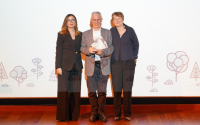4 May 2006
Cameron Todd Willingham is the first and only man executed in the United States for suspected arson after his three children, all under the age of three, burned to death at their home in Corsicana, about an hour's drive south-east of Dallas, Texas, in December 1991.
Willingham testified at his trial that he narrowly escaped the fire himself, that he tried and failed to rescue his children, that he then made repeated attempts to call for help and re-enter the building, at one point smashing a window with a pool cue in the hope of reaching the children's bedrooms.
Not everyone, though, believed him. One of his neighbours, who knew he was a drifter, knew he had trouble holding down a job and knew about his fondness for going out to drink beer and play darts, thought he hadn't done nearly enough to save his family.
When the fire marshals examined the aftermath of the fire, they too found some anomalies and began to wonder if Willingham hadn't set it deliberately. Particularly damning at his trial was the testimony of the deputy state fire marshal, Manuel Vasquez, who examined the burn patterns on the wood floor and the melted aluminium threshold piece, as well as the way certain pieces of glass has cracked into crazy patterns in the heat, and told the jury there was no way this was the result of an accident. Someone, presumably Willingham, had sprinkled fuel and set light to the building.
"The fire tells a story," Mr Vasquez said on the stand at Willingham's trial. "I am just the interpreter. I am looking at the fire, and I am interpreting the fire. That is what I know. That is what I do best. And the fire does not lie. It tells the truth."
Willingham was duly convicted of murder and, after 12 years on death row, was executed by lethal injection in February 2004.
Now, though, compelling evidence has emerged that Mr Vasquez did not in fact know what he was talking about. None of his testimony has passed muster with a panel of acknowledged arson experts, which has gone over it in detail. And without his testimony, the case against Willingham is left essentially baseless. Unlike most capital convictions, where a defendant's protestations of innocence raise the question of who else might have committed the crime, this case may well have constituted no criminal behaviour whatsoever, just one more ghastly element in an unspeakable family tragedy. That is certainly what Willingham asserted as he went to his death. "The only statement I want to make is that I am an innocent man, convicted of a crime I did not committed," he said. "I have been persecuted for 12 years for something I did not do."
Thanks to the work of the New York-based Innocence Project - a team of defence lawyers who put dubious capital convictions under the microscope of modern technology - his protest is looking increasingly believable.
The group commissioned a real expert's report using advances in the understanding of arson evidence which will make uncomfortable reading for the prosecution in the Willingham case. Their findings will this week be handed to the Texas Forensic Science Commission, which is constitutionally bound to launch its own investigation and report back to Governor Rick Perry, the man who gave the green light to Willingham's execution.
The Innocence Project's report will be hard to argue with. It was compiled by four of the country's leading arson experts who have testified on behalf of defence and prosecution in previous cases. Their conclusion: Willingham's conviction was based on bad science, and none of the evidence should have ever led investigators to believe the fire was set deliberately. "While we have no doubt that ... witnesses believed what they were saying, each and every one of the indicators relied upon have since been scientifically proven to be invalid," the report says.
And so the stage is set for the next big showdown over the death penalty in the US. Already, the pace of executions in most states has slowed because of doubts in recent years about the safety of capital convictions. The release of death row inmates shown by DNA evidence and other methods to have been innocent of the crimes of which they were accused is steadily increasing.
And a host of other doubts are being introduced. California's execution machine is at a standstill because of evidence that the lethal drugs administered during executions merely mask the pain felt by the dying prisoner instead of eliminating it. Reports emerged from Ohio on Tuesday of convicted murderer Joseph Lewis Clark taking 90 minutes to die after the team trying to deliver a lethal injection had problems finding a suitable vein.
The Project's lawyers have been instrumental in forcing courts to take new DNA-testing technology into account when reviewing convictions. Since 1992, when the Innocence Project first began, 175 prisoners have been exonerated, including 14 who spent time on death row.
It was the Project's lawyers who first questioned the arson evidence. They assembled the panel of experts and commissioned the report. More strikingly, they were also responsible for lobbying the Texas authorities and bringing about the existence of the Forensic Science Commission in the first place.
As the Innocence Project itself put it in a statement, the release of its report "marks the first time in the nation that scientific evidence showing an innocent person was executed has been submitted to a government entity that is legally obligated to investigate cases, reach conclusions and direct system-wide reviews to determine the extent of the problem". In other words, it could conceivably be the beginning of the end of the death penalty in Texas.
It also spells political trouble for Governor Perry as he faces an election race this November. Many of the arson panel's conclusions had been reached even before Willingham's execution, by a Cambridge-educated arson expert called Gerald Hurst, who passed on his findings to the Governor's office. As he told an investigative team from the Chicago Tribune at the time: "There's nothing to suggest to any reasonable arson investigator that this was an arson fire. It was just a fire." It does not appear, however, that Dr Hurst's findings were taken seriously by either the Governor's office or the state Board of Pardons and Paroles.
Barry Scheck, one of the two principles of the Innocence Project, who remains perhaps most famous for his role in defending O J Simpson, said he had established through open records requests that the Hurst report had indeed been properly filed before the execution.
"Neither office has any record of anyone acknowledging it, taking note of its significance, responding to it or calling any attention to it within the government," he said. "The only reasonable conclusion is that the Governor's office and the Board of Pardons and Paroles ignored scientific evidence and went through with the execution."
The prosecution, meanwhile, presented last-minute, second-hand evidence that Willingham had confessed to his estranged wife, something she later said was untrue.
Perhaps most poignant for Willingham's surviving relatives is that, at the time of execution, a similar case was going through the Texas legal system, that of Ernest Willis, who had been sentenced to death for his alleged role in setting a fatal fire in west Texas in 1987. Dr Hurst examined his case, too, found the forensic evidence similarly flawed and said he saw no evidence of arson. Willis was able to have his case reopened and dismissed. He walked out of death row a free man seven months after Willingham's execution.
All this adds up to a potentially explosive cocktail of political and social issues. Texans may be more attached than most Americans to the death penalty, but even they tend to draw the line at putting innocent people to death. One candidate in the governor's race, the humourist and former singer Kinky Friedman, does not appear to have been harmed by his record of campaigning on behalf of death row prisoners. One of Friedman's campaign lines is: "Texas: 50th in education, first in executions... how's that working for you?"
If the political tide is turning slowly, the sense of discomfort in the professional world of forensics and legal analysis is starting to be overwhelming. Copycat Innocence Projects have been set up. The original one, meanwhile, has been at the forefront of denouncing errors and unprofessional behaviour at forensic crime labs around the country, most notably in Virginia, Texas and Ohio.
The group has also made disturbing findings about the functioning of the criminal justice system more generally. The Innocence Project has found that the single biggest cause of wrongful convictions is mistaken eyewitness identification testimony. In more than a third of cases, forensic science has also been misapplied in some way, with experts presenting "fraudulent, exaggerated, or otherwise tainted evidence to the judge or jury".
Six years ago, the state of Illinois issued a blanket commutation of all its death sentences after it was established that 13 people on death row were in fact innocent of the crimes of which they were committed. (In that case, it was journalism students at Northwestern University who did the legwork.) Much more recently, New York state chose not to reinstate its death penalty law.
The backlash against capital punishment may be coming too late for Willingham, but his case remains a potent weapon in the hands of the Innocence Project and other campaigners. If Texas, of all states, is forced to acknowledge it killed an innocent man, then the death penalty may be on its way to extinction.
http://news.independent.co.uk/world/americas/article361812.ece






